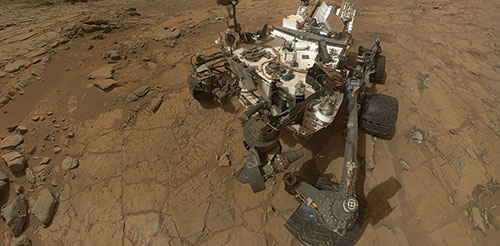The watery past of Mars
Published: 2 May 2013
Scientists conducting tests on a 1.7-gram fragment of a Martian meteorite have uncovered the first evidence of water dissolving the surface of Mars.
Scientists conducting tests on a 1.7-gram fragment of a Martian meteorite have uncovered the first evidence of water dissolving the surface of Mars.

Blasted from the surface of Mars by a massive impact around 10 million years ago, the meteorite is named Nakhla after the town in Egypt where it landed in 1911. Over the years since then, scientists from across the globe have conducted research on Nakhla, finding evidence of the existence of water on Mars through the presence in the meteorite of ‘secondary minerals’ – types of carbonates, hydrous silicates and sulfates most likely formed when Martian minerals reacted with liquid water.
Now, experts from the University, the Scottish Universities Environmental Research Centre and the Natural History Museum London, who provided the fragment for testing, have been able to show where the chemical elements that made up the secondary minerals came from.
Professor Martin Lee explains: ‘We examined many tiny bowl-shaped depressions, known as etch pits, in grains of the minerals olivine and augite found in the meteorite. We found evidence that the etch pits were created when water dissolved the olivine and augite, and that the elements released from those minerals led to the formation of the secondary minerals.’
From the amount of dissolution observed, it’s likely that this piece of Mars was affected by water for only a few months, raising fascinating questions about where the water might have gone.
Professor Lee says: ‘We’ll be continuing to look for the answers to these questions in future research. Results from NASA’s Curiosity rover, currently on the surface of Mars, will also help us build a clearer picture of the history of Martian water.’
Related pages
- Prof Martin Lee
- Water and life in the solar system
- School of Geographical & Earth Sciences
- College of Science & Engineering
First published: 2 May 2013
<< News

